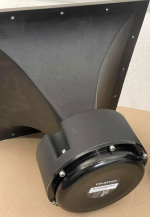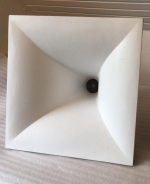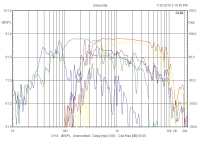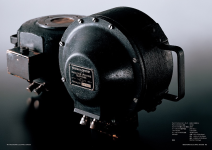the difference between horn and waveguide can be somewhat moot unless there is either compression or folding involved - then you know it's a horn
i mean a flat baffle is also a waveguide if you think about it
i guess the difference between horn and waveguide is a horn is intended to boost output at all frequencies at which a driver operates while a waveguide may boost some frequencies and not others and is intended to control directivity instead
but in the end whether it's a baffle, a waveguide or horn it's a boundary that creates acoustical loading and affects frequency response, efficiency and directivity.
it's just what with baffles we focus on edge diffraction / baffle step. with waveguides we focus on upper frequency directivity and with horns on frequency response.
but those are just limitations of our mental models - they aren't real distinctions. if some Finite Element Analysis software had to model those things it would use the same exact math to model a baffle, a waveguide and a horn. because in the end air is air and boundary is boundary.
we have to make artificial distinctions in order to come up with useful approximations that keep the math down to something we humans can work with because our ability to do math is MANY orders of magnitude below that of computers ...
but ironically as the power of computers grows the math they use is getting simpler ... because the level of abstraction required to solve a problem is getting lower ... with enough processing power things can be modeled directly without approximation which is more number crunching but fewer formulas ...
Mostly agree with your views, but the most important thing is to consider the electro-mechano-acoustical (EMA) analogy.
Microphones and loudspeakers consist of coupled mechanical, acoustical and electrical subsystems.
Analysis has to consider all subsystems in an integral way.
Kolbrek doesn't say anything in that quote that answers what I asked. In fact, the last sentence appears malformed so it looks as though the quote is incomplete.
Quite the contrary, at cutoff an exponential horn has no output but that's not a concern with an OS waveguide, is it?
As I stated:
They do, but more gradually (in the case of an OSWG).
To quote Bjørn Kolbrek:
"The OS waveguide does not have a sharp cutoff like the exponential or hyperbolic horns, but it is useful to be able to predict at what frequency the throat impedance of the waveguide becomes too low to be useful. If you set this frequency at the point where the throat resistance is 0.2 times its asymptotic value, so that the meaning of the cutoff frequency becomes similar to the meaning of the term as used with exponential horns."
View attachment 1430250
You 'could' use an OSWG in '(mass) reactive mode' and push the driver below its comfort zone, but it won't sound particularly nice and you risk frying 'phrams at higher SPL, as Geddes found out when some of his speakers were used in a club.
No, again you're trying to make this about driver excursion.
I'm talking about the waveguide alone used down through the reactive region. No driver limitations. What does it sound like?
I'm talking about the waveguide alone used down through the reactive region. No driver limitations. What does it sound like?
What do you think?
What's the point of considering the waveguide without a driver (= no sound)?
Of course, with a powerful driver, e.g. the Axi2050, an OSWG could also be crossed lower, but still not as low as with a classic horn.
This topic has been flogged to death. Opinions will always differ, perhaps with the exception of the pro audio community.
What's the point of considering the waveguide without a driver (= no sound)?
Of course, with a powerful driver, e.g. the Axi2050, an OSWG could also be crossed lower, but still not as low as with a classic horn.
This topic has been flogged to death. Opinions will always differ, perhaps with the exception of the pro audio community.
Last edited:
Here's an example of someone who swapped the BMS 4592ND for the Axi2050, actively crossed at 300 Hz, but using the BD-Design Oris horns (150 Hz cutoff).

You could get away with a huge OSWG (40 or 60° included angle) and the same XO, but I doubt it would yield satisfactory results.
You could get away with a huge OSWG (40 or 60° included angle) and the same XO, but I doubt it would yield satisfactory results.
i previously said all modern compression drivers are annual but i take it back
this dome driver is modern:
https://audioxpress.com/article/test-bench-faital-pro-s-new-hf1460-pro-sound-compression-driver-1
and would be a very good choice from about 1.5 khz to 8 khz
you could use a supertweeter and perhaps a 8" paper midrange to complete the setup
this dome driver is modern:
https://audioxpress.com/article/test-bench-faital-pro-s-new-hf1460-pro-sound-compression-driver-1
and would be a very good choice from about 1.5 khz to 8 khz
you could use a supertweeter and perhaps a 8" paper midrange to complete the setup
Troy Crowe designed a large OSWG.
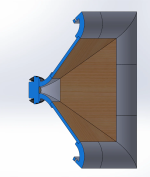
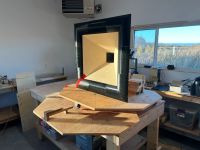
Specification
" The idea is to provide a large format oblate spheroidal horn flare which is characterized as a conical horn with a smooth throat transition.
Design Goals
By moving the mic away to 1m, removing the gate, and applying some smoothing,
we get a better sense on what happens near the cutoff frequency of the horn:
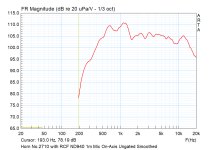
Response at 0,15,30, & 45 degrees off-axis:
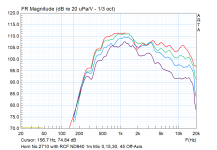
Below is the response of the Yuichi A290 with the RCF ND940/950.
Please note that the ND940 is simply the ND950 with the conical adapter removed. So we are using the same driver between tests:
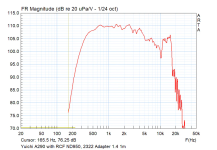
For additional comparison data I've shown the ES-290 biradial with the same RCF compression driver:"
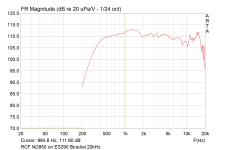
Considering the 35cm depth it's respectable, but the loading characteristics are certainly not in the same ballpark as the Yuichi, let alone the Oris horn.
600 Hz seems to be the lowest usable frequency.
But this should come as no surprise.


Specification
- Horn mouth 85cm x 85cm (with mouth flares)
- Horn mouth 58cm x 58cm (without flares)
- Cutoff Frequency 300Hz (Fc)
- Coverage 90 degrees.
" The idea is to provide a large format oblate spheroidal horn flare which is characterized as a conical horn with a smooth throat transition.
Design Goals
- Easy to construct for DIY enthusiasts
- Horn throat can be 3D printed
- Horn petals are easy to construct especially compared to the Sabourin horn which consists of three flare segments. This Oblate Spheroidal (OS) consists of a single horn flare segment.
- The horn mouth flares are optional (see test data to compare with and without mouth flare pieces)
- Suitable for home theater, home hifi, and PA applications
- Provides constant directivity for use in PA
- Attempts low coloration sound
- Most Constant Directivity (CD) horns have high coloration due to abrupt physical horn flare geometry
- Provide reasonable falling response
- Most CD horns have significant falling response requiring EQ to flatten. This raises distortion in the treble region since the driver is having to work hard to reproduce those frequencies compared to an exponential horn flare.
By moving the mic away to 1m, removing the gate, and applying some smoothing,
we get a better sense on what happens near the cutoff frequency of the horn:

Response at 0,15,30, & 45 degrees off-axis:

Below is the response of the Yuichi A290 with the RCF ND940/950.
Please note that the ND940 is simply the ND950 with the conical adapter removed. So we are using the same driver between tests:

For additional comparison data I've shown the ES-290 biradial with the same RCF compression driver:"

Considering the 35cm depth it's respectable, but the loading characteristics are certainly not in the same ballpark as the Yuichi, let alone the Oris horn.
600 Hz seems to be the lowest usable frequency.
But this should come as no surprise.
Troy Crowe designed a large OSWG.
View attachment 1430624View attachment 1430625
Specification
- Horn mouth 85cm x 85cm (with mouth flares)
- Horn mouth 58cm x 58cm (without flares)
- Cutoff Frequency 300Hz (Fc)
- Coverage 90 degrees.
" The idea is to provide a large format oblate spheroidal horn flare which is characterized as a conical horn with a smooth throat transition.
Design Goals
- Easy to construct for DIY enthusiasts
- Horn throat can be 3D printed
- Horn petals are easy to construct especially compared to the Sabourin horn which consists of three flare segments. This Oblate Spheroidal (OS) consists of a single horn flare segment.
- The horn mouth flares are optional (see test data to compare with and without mouth flare pieces)
- Suitable for home theater, home hifi, and PA applications
- Provides constant directivity for use in PA
- Attempts low coloration sound
- Most Constant Directivity (CD) horns have high coloration due to abrupt physical horn flare geometry
- Provide reasonable falling response
- Most CD horns have significant falling response requiring EQ to flatten. This raises distortion in the treble region since the driver is having to work hard to reproduce those frequencies compared to an exponential horn flare.
By moving the mic away to 1m, removing the gate, and applying some smoothing,
we get a better sense on what happens near the cutoff frequency of the horn:
View attachment 1430631
Response at 0,15,30, & 45 degrees off-axis:
View attachment 1430626
Below is the response of the Yuichi A290 with the RCF ND940/950.
Please note that the ND940 is simply the ND950 with the conical adapter removed. So we are using the same driver between tests:
View attachment 1430628
For additional comparison data I've shown the ES-290 biradial with the same RCF compression driver:"
View attachment 1430630
Considering the 35cm depth it's respectable, but the loading characteristics are certainly not in the same ballpark as the Yuichi, let alone the Oris horn.
600 Hz seems to be the lowest usable frequency.
But this should come as no surprise.
Troy's own conclusion:
"While the horn sounded dynamic, intelligible, and coherent, it lacked the last little bit of clarity I've come to expect. This limitation reduced overall soundstage depth and smoothness, having some mild horn coloration. As a result the 2710 horn is perfectly suitable for PA applications or for home theater applications where dynamics and intelligibly are of primary concern. I would not use the 2710 horn in two channel music applications."
"This limitation reduced overall soundstage depth and smoothness, having some mild horn coloration."
For comparison (and fwiw), here's a review of a loudspeaker system that uses the same spherical horn (post #69), by one of the most renowned DIY-ers in Germany.
For comparison (and fwiw), here's a review of a loudspeaker system that uses the same spherical horn (post #69), by one of the most renowned DIY-ers in Germany.
"The first thing that strikes you is the excellent imaging ability of the speakers."
and:
"The timbres are spot on, with not a trace of the typical horn coloration."
and:
"The timbres are spot on, with not a trace of the typical horn coloration."
Attachments
Last edited:
i previously said all modern compression drivers are annual but i take it back
The Western Electric 555W is generally considered the first high frequency compression driver, it used a 3.3" (84mm) dome diaphragm with a phase plug using four annular rings in 1926.
Most HF compression drivers still use very similar phase plug designs.
About 29 years later, JBL released the annular diaphragm ("ring radiator") 075 "bullet tweeter" in 1955, 70 years ago.
The tiny annular diaphragms of the 075 (or 2402, 2404, 2405 etc.) could "get by" with a single annular ring phase plug/horn.
Larger annular ring diaphragms with diaphragm area (Sd) approaching a 3" or 4" dome diaphragm may use two annular rings in the as in the BMS4592:
or three annular rings in the more recent Celestion Axi2050:
Anyway, the "30% more modern by age" annular diaphragms do have the advantage of requiring less of a span for the diaphragm material, but require two suspensions rather than one for a dome.
As usual, there are trade-offs in every design choice.
Art
Axiperioic is an exercise in FEM and not a useful driver.
Dual 3" JBL driver effectively has a larger 6" VC at a fraction of cost and weight. I watched the presentation Dr. Brown did about how he designed the Axi and he wasn't even trying to hide the fact it was not much more than his PHD thesis ( about modeling diaphragm modes ) turned into a driver, and he all but stated that the driver was useless except maybe for cinema speakers.
Yeah it's impressive as a science experiment but not useful. Like a 2012 Tesla Model S - showed the future but objectively wasn't a great car.
BMS is an actually useful driver, while also being extremely innovative when it came out, though it was a longer time ago. BMS is based on understanding of physics rather than on mathematical modeling like Axi.
and the RCF dome that i linked uses cutting edge metamaterial diaphragm in an otherwise pedestrian, century old driver design. i think it would be brilliant with a supertweeter because it is ruler flat to about 8 khz where the supertweeter can take over.
Dual 3" JBL driver effectively has a larger 6" VC at a fraction of cost and weight. I watched the presentation Dr. Brown did about how he designed the Axi and he wasn't even trying to hide the fact it was not much more than his PHD thesis ( about modeling diaphragm modes ) turned into a driver, and he all but stated that the driver was useless except maybe for cinema speakers.
Yeah it's impressive as a science experiment but not useful. Like a 2012 Tesla Model S - showed the future but objectively wasn't a great car.
BMS is an actually useful driver, while also being extremely innovative when it came out, though it was a longer time ago. BMS is based on understanding of physics rather than on mathematical modeling like Axi.
and the RCF dome that i linked uses cutting edge metamaterial diaphragm in an otherwise pedestrian, century old driver design. i think it would be brilliant with a supertweeter because it is ruler flat to about 8 khz where the supertweeter can take over.
OK, so you haven't tried it. That's all you needed to say.What's the point of considering the waveguide without a driver
No. The directivity is going to give out at a higher frequency with the classic horn, below which there's cutoff to steer clear of.Of course, with a powerful driver, e.g. the Axi2050, an OSWG could also be crossed lower, but still not as low as with a classic horn.
Axiperioic is an exercise in FEM and not a useful driver.
Dual 3" JBL driver effectively has a larger 6" VC at a fraction of cost and weight. I watched the presentation Dr. Brown did about how he designed the Axi and he wasn't even trying to hide the fact it was not much more than his PHD thesis ( about modeling diaphragm modes ) turned into a driver, and he all but stated that the driver was useless except maybe for cinema speakers.
Yeah it's impressive as a science experiment but not useful. Like a 2012 Tesla Model S - showed the future but objectively wasn't a great car.
BMS is an actually useful driver, while also being extremely innovative when it came out, though it was a longer time ago. BMS is based on understanding of physics rather than on mathematical modeling like Axi.
and the RCF dome that i linked uses cutting edge metamaterial diaphragm in an otherwise pedestrian, century old driver design. i think it would be brilliant with a supertweeter because it is ruler flat to about 8 khz where the supertweeter can take over.
Tbh 'm not fond of annular diaphragms in general - this applies to tweeters and compression drivers.
Inner workings of the 4592ND:
The channels in the B&C DCX354 seem to be optimized:
Tried what? A naked compression driver without horn/waveguide?OK, so you haven't tried it. That's all you needed to say.
No. The directivity is going to give out at a higher frequency with the classic horn, below which there's cutoff to steer clear of.
B&C DE75/82 behind a sheet of plywood with a slightly reworked (exit) hole. Works fine from 800 Hz with just a protection cap at low output levels, but the driver obviously sounds (and works) better with a horn.
As for directivity in HF, I don't care about (hardly inevitable) increasing directivity, as long as it happens gradually/smoothly.
I don't think horn speakers are useful for near field listening, except in Camplo's specific case.
Last edited:
BMS uses 45 degree high frequency mirrors that reflect HF at 90 degree angles.The channels in the B&C DCX354 seem to be optimized:
B&C just tries to bend sound but sound is a wave not a metal rod. It doesn't bend - it reflects.
JBL has got it right with D2 in my opinion. But they just wire both voice coils in parallel ( or is it series ? ) They should have made it with a crossover like the others.
compression drivers are limited in the very high frequencies ( above 10 khz ) so the small supertweeter is a problem. JBL D2 has 3" on both coils and both are basically wide band supertweeters - which is the better design.
compression drivers are limited in the very high frequencies ( above 10 khz ) so the small supertweeter is a problem. JBL D2 has 3" on both coils and both are basically wide band supertweeters - which is the better design.
it's what i was talking about. the trend is to move from compression drivers with deep horns trying to reproduces low frequencies to basically giant supertweeters like D2.
prosound is all about arrays and arrays have a high frequency roll off due to phase issues, additionally air absorbs high frequencies over distances found in venues so in practice compression driver goal is to produce as much of very high frequency output as possible and midrange output is relegated to paper cones to allow designers to fully optimize compression drivers for VHF.
using compression drivers for midrange is pointless. there are many prosound paper midranges in 8" and 10" sizes with over 100db efficiency BEFORE any horn loading.
by asking a compression driver to do the job of a midrange you are inevitably compromising its VHF performance either by using a wider diaphragm or deeper horn. even a coaxial design like BMS or B&C is still a compromise.
use a D2 with a paper midrange !
JBL has got it right with D2 in my opinion. But they just wire both voice coils in parallel ( or is it series ? ) They should have made it with a crossover like the others.
It is a push-push (cancellation) design, which can be connected in parallel or series:
- Series VC: 104 db on the M2 horn
- Parallel VC: 110 db on M2 horn.
It's an advanced driver, albeit very expensive, quite fragile and almost impossible to repair.
Last edited:
- Home
- Loudspeakers
- Multi-Way
- BMS 4592 vs Radian Beryllium
